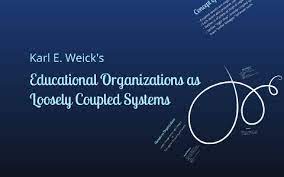This post is a discussion of Karl Weick’s classic essay, “Educational Organizations as Loosely Coupled Systems,” which was published in Administrative Science Quarterly in 1976. Here’s a link to the original.
The essay begins with this wonderful thought experiment:
Imagine that you’re either the referee, coach, player or spectator at an unconventional soccer match: the field for the game is round; there are several goals scattered haphazardly around the circular field; people can enter and leave the game whenever they want to; they can throw balls in whenever they want; they can say “that’s my goal” whenever they want to, as many times as they want to, and for as many goals as they want to; the entire game takes place on a sloped field; and the game is played as if it makes sense (March, personal communication).
If you now substitute in that example principals for referees, teachers for coaches, students for players, parents for spectators and schooling for soccer, you have an equally unconventional depiction of school organizations. The beauty of this depiction is that it captures a different set of realities within educational organizations than are caught when these same organizations are viewed through the tenets of bureaucratic theory.
Think about how loosely coupled US school systems are. They exist across six levels, each nested in the other: Federal, state, district, school, classroom, and student. Each level is partially autonomous, buffered from the level above. Each unit is also buffered from others at the same level. Units at each level and across levels are physically separated, operating independently. In such a structure, it is very difficult to effect change down the hierarchy, and it’s also not easy to disseminate change across units at the same level.
This has been a chronic source of frustration for impatient school reformers. In many ways, the central aim of the standards movement in education (NCLB, etc.) has been to remedy this situation by trying aggressively to make the system more tightly coupled, using curriculum standards and high stakes tests.

Weick goes on to talk about the traditional view of organizations:
An organization does what it does because of plans, intentional selection of means that get the organization to agree upon goals, and all of this is accomplished by such rationalized procedures as cost-benefit analyses, division of labor, specified areas of discretion, authority invested in the office, job descriptions, and a consistent evaluation and reward system. The only problem with that portrait is that it is rare in nature. People in organizations, including educational organizations, find themselves hard pressed either to find actual instances of those rational practices or to find rationalized practices whose outcomes have been as beneficent as predicted, or to feel that those rational occasions explain much of what goes on within the organization.
Loosely-coupled systems like school organizations make it hard to exert control from above and disseminate change, either vertically or horizontally. But these apparent weaknesses can become strengths for a number of purposes. Consider these functions of loosely-coupled systems:
- A loosely coupled system may be good for promoting localized adaptation as opposed to compelling standardized practices.
- The system potentially can retain a greater number of mutations and novel solutions than would be the case with a tightly coupled system. It’s comfortable with heterogeneity.
- If there is a breakdown in one portion of a loosely coupled system, then this breakdown is relatively sealed off and does not affect other portions of the organization.
- In a loosely coupled system there is more room available for self-determination by the actors.
- A loosely coupled system should be relatively inexpensive to run, because uses up a lot less of the time and money that it takes to coordinate people.
Weick argues that in loosely-coupled systems like schools, there is an interesting tradeoff. These organizations maintain loose control of work but tight control of certification.
It is further being suggested that in the case of educational organizations there is loose control of the work – the work is intrinsically uninspected and unevaluated or if it is evaluated it is done so infrequently and in a perfunctory manner — but that under these conditions it becomes crucial for the organization to have tight control over who does the work and on whom.
But this raises an interesting question:
If the task in an educational organization is diffuse then why do all educational organizations look the way they do, and why do they all look the same? One possible answer is that the tasks of educational organizations do not constrain the form of the organization but rather this constraint is imposed by the ritual of certification.
This recalls the Schooling Rule formulated by Meyer and Rowan: “Education is a certified teacher teaching a standardized curricular topic to a registered student in an accredited school.”
Welcome to the wonderful world of schooling, where form is function.
If you are comfortable with a messy organizational structure and value relative autonomy for schools and teachers, locally adaptable practices, variability over consistency, and the possibility of fostering innovation at the level of school and classroom, then a loosely-coupled system is for you.

